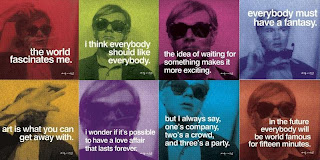
While many people know about Andy Warhol and the effect his artwork and style had on the contemporary art movement in the 1960’s, people are generally unaware of the influence he had on early American rock bands of the same era. The late 50’s and early 60’s were a time of change for the art industry in the United States and the U.K.. Contemporary artworks (what some saw as trash at the time) was becoming more and more popular among younger generations. Not only were the works in galleries changing, but the music was changing as well. Arguably one of the most influential bands of this period was The Velvet Underground, a band founded in New York City which would be sky-rocketed to fame with the help of their producer, Andy Warhol, and his ‘Business Art.’
Warhol’s idea behind business art came from his idea that he didnt run his art business, his art business ran him, that helped him realize that business art is the best art. Andy Warhol Enterprises, Andy’s company, was a movie making company. With the movies his company made, came out-takes, and with these out-takes, came an idea. Andy loved these out-takes, what he called leftovers, and he thought in some cases they were better (funnier) than the actual films. He needed to find something to do with them, and that is where The Velvet Underground came in.
The Velvet Underground gained their fame once Andy Warhol became their manager and the band became part of his Exploding Plastic Inevitable showcase. Andy used his influence in the art scene in New York to promote The Velvet Underground, and then he found out what to do with his leftovers-project the broken bits of film over the band as they played. This, combined with the Undergrounds imitable style produced an act that was the first of its kind and was a true combination of visual and performative arts. Andy was taking the style from the happenings and creating music showcases which began to involve the audience more and more.
https://www.youtube.com/watch?v=eFd9h5IG5XQ
With these shows, Warhol was able to influence new musical artists such as Pink Floyd, David Bowie and Peter Gabriel to escape the norm of music of the period and turn it not only into a harmonious, but a visual and performative act as well. Warhol’s influences can still (arguably, I must say) be seen in bands like Gwar, and Slipknot as they are not only attacking and changing music, but are changing the physical and performative aspect as well, much like the early contemporary artists of the 60’s did with art.
